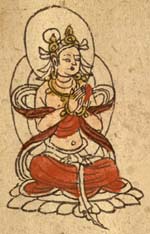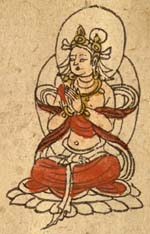
Buddhist Travellers on the Silk Road


|
Buddhist Travellers on the Silk Road |

|
|
Once Buddhism became established in China, many Chinese devotees wished to make the journey to India, the sacred land in which Buddhism was born. The Silk Road was only land route by which the journey could be made, and despite the danger and length of the journey, many monks attempted it. The journeys of two monks in particular became famous because of the accounts which they wrote about their travels. They were Faxien and Xuanzang.
Faxian, a Buddhist monk from China, travelled across the Silk Road to India on a pilgrimage, intending to visit holy sites, and to collect Buddhist scriptures which he could bring back to his homeland. He left the city of Changan in the year 399 CE, and travelled west to Dunhuang, where he stayed for several weeks. The governor of Dunhuang provided him with the support to cross the desert. On the other side of the desert Faxian stayed in Khotan for three months. He was particularly impressed with the number of monasteries in Khotan, and the commitment of its Buddhist monks and lay-people. Leaving Khotan, he travelled to Gandhara, and then travelled into northern India, which was at that time under Gupta rule. Faxian spent six years there before returning by sea to China, arriving back in 413. Xuanzang (Hsuan-tsang)Xuanzang was, like Faxian, a Chinese Buddhist monk. He was also a translator of Buddhist scriptures, who had resolved to travel to India in order to bring back more Sanskrit manuscripts to translate into Chinese. Xuanzang left China in 629, without the emperor's permission, which meant that he had to avoid Dunhuang and strike out directly into desert. He followed the northern branch of the Silk Road, and arrived in Turfan, where he was warmly welcomed by the king. In fact, such was the king's esteem for him that Xuanzang had some difficulty leaving, but eventually the king provided him with letters of introduction to the other Silk Road oasis states along his route.
Xuanzang continued his journey through cities such as Tashkent, Samarkand and Peshawar before arriving in Northern India. In India he studied in the great monastic university Nalanda, and spent several years making pilgrimages to Buddhist holy sites. On his return to China, he travelled along the southern branch of the Silk Road, through Khotan to Dunhuang. His journey had lasted fifteen years. Xuanzang brought many Buddhist scriptures back with him, some of which he himself translated into Chinese. His detailed account of his travels made him famous, and he became the subject of popular folktales and an epic novel, The Journey to the West (Xiyouji). This version of Xuanzang's story is best known in English through Arthur Waley's translation, Monkey - see Further Reading). |
|
Buddhism on the Silk Road | The doctrines of Buddhism | The history of Buddhism |